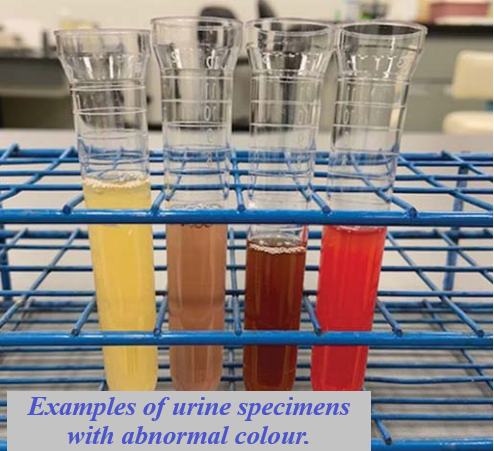Why Does Urine Comes With Varieties of Colour and Odor?

Why does urine comes with varieties of Colour and Odor?
The colour of urine varies from almost colourless to black.
These variations may be due to normal metabolic functions, physical activity, ingested materials, or pathological conditions.
A noticeable change in urine colour is often the reason that a patient seeks medical advice; then it becomes the responsibility of the laboratory to determine whether this colour change is normal or pathological.
The terminology used to describe the colour of normal urine may differ slightly among laboratories but should be consistent within each laboratory.
Common descriptions include pale yellow, yellow, and dark yellow.
A normal urine colours.
Care should be taken to examine the urine under a good light source, looking down through the container against a white background.
The yellow colour of urine is caused by the presence of a pigment, which Thudichum named urochrome in 1864.
Urochrome is a product of endogenous metabolism, and under normal conditions, the body produces it at a constant rate.
The actual amount of urochrome produced is dependent on the body’s metabolic state, with increased amounts produced in patients with thyroid conditions and/or those in fasting states.
Urochrome also increases in urine which stands at room temperature.
Because urochrome is excreted at a constant rate, the intensity of the yellow colour in fresh urine is.
A dilute urine will be pale yellow, and a concentrated urine will be dark yellow.
Remember that due to variations in the body’s state of hydration, these differences in the yellow colour of urine can be normal.
Two additional pigments, uroerythrin and urobilin, are also present in the urine in much smaller quantities, and they contribute little to the colour of normal, fresh urine.
The presence of uroerythrin, a pink pigment, is most evident in specimens that have been refrigerated, resulting in the precipitation of amorphous urates in acid urine.
Uroerythrin attaches to the urates, giving a pink colour to the sediment.
Urobilin, an oxidation product of the normal urinary constituent urobilinogen, imparts an orange-brown colour to urine that is not fresh.
Abnormal urine colours are as numerous as their causes.
Certain colours, however, are seen more frequently and have a greater clinical significance than others.
Urine colour and possible causes.
Pale yellow-coloured Urine
Caused by the presence of;
- Polyuria or diabetes insipidus
- Diabetes mellitus
Dark yellow colour
Caused by the presence of;
- Excess B complex vitamins
- Dehydration
- Excess Bilirubin
- Acriflavine
- Nitrofurantoin
Orange-yellow colour.
Cause:
- Phenazopyridine (Pyridium)
- Phenindione
- Sulfasalazine (Azulfidine)
Blue-green coloured Urine
Caused by;
Pathogenic causes of blue/green urine are limited to bacterial infections, including urinary tract infection by Pseudomonas species, and intestinal tract infections, resulting in increased urinary indican.
Familial benign hypercalcemia, a rare inherited disorder, is sometimes called “blue diaper syndrome” because children with the disorder will have blue urine.
Ingestion of breath deodorizers (Clorets) can result in green urine.
Brightly coloured food dyes, B vitamins, and asparagus also can cause green urine.
The medications methocarbamol (Robaxin), methylene blue, indomethacin (Indocin, Tivorbex), amitriptyline (Elavil), and propofol (Diprivan) may cause blue urine.
- Amitriptyline
- Methocarbamol (Robaxin)
- Clorets
- Indican
- Methylene blue
- Phenol
- Propofol
- Familial hypercalcemia
- Indomethacin (Indocin, Tivorbex)
Pink Red coloured urine
(Cloudy specimen with RBCs, mucus, and clots)
Causes by the presence of;
- Red blood cells (RBCs)
- Haemoglobin
- Myoglobin
- Beets
- Rifampin
- Menstrual contamination
Brown Black coloured urine
Caused by the presence of;
- Homogentisic acid (alkaptonuria)
- Malignant melanoma
- Melanin or melanogen
- Phenol derivatives
- Argyrol (antiseptic)
- Methyldopa or levodopa
- RBCs
- Metronidazole (Flagyl)
- Chloroquine and primaquine
- Methocarbamol
- Fava beans, rhubarb, or aloe

Urine Odor
- Although it is seldom of clinical significance and is not a part of the routine urinalysis, urine odor is a noticeable physical property.
- Freshly voided urine has a faint aromatic odor.
- As the urine stands, the odor of ammonia becomes more prominent.
- The breakdown of urea is responsible for the characteristic ammonia odor.
- Causes of unusual odors include bacterial infections, which cause a strong, unpleasant odor similar to ammonia, and diabetic ketones, which produce a sweet or fruity odor.
- A serious metabolic defect results in urine with a strong odor of maple syrup and is called, appropriately, maple syrup urine disease.
- Ingestion of certain foods, including onions, garlic, and asparagus, can cause an unusual or pungent odor in urine.
- Studies have shown that although everyone who eats asparagus produces an odor, genetically predisposed and only certain people can smell it.
Join Enlighten Knowledge WhatsApp platform.
Join Enlighten Knowledge Telegram platform.
Follow our:
FACEBOOK PAGE.







Nice post. I learn something more challenging on different blogs everyday. It will always be stimulating to read content from other writers and practice a little something from their store. I’d prefer to use some with the content on my blog whether you don’t mind. Natually I’ll give you a link on your web blog. Thanks for sharing.
Simply a smiling visitor here to share the love.